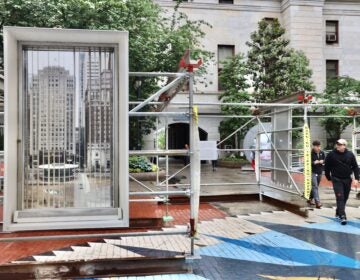Germantown art district gains steam
Germantown has plenty of artists. What it lacks is a cohesive art scene.
That’s why Vivian Nix-Early is working with a group of neighborhood activists to create a designated art district in Germantown.
The art district would be announced on banners along the street, and would help arts venues and individual artists attract visitors during regular events such as First Friday.
“This is a creative community,” Nix-Early said. She and her colleagues are hoping that a little more collaboration, planning and publicity will help Germantown artists find greater success, and attract new artists and arts-related businesses to the area.
Nix-Early, who cofounded Germantown’s arts-based nonprofit BuildaBridge with Nathan Corbitt, is a member of the Classic Towns Germantown working group. Classic Towns is chaired by David Hamme under the aegis of Germantown Community Connection. Its goal is to market the good things about Germantown in the hopes of attracting more visitors, residents, and businesses to the neighborhood.
In Hamme’s opinion, artists are one of the things Germantown has going for it, and they should be shown to better advantage.
“We want to make Germantown a clear destination for people in the arts,” he said.
Local artists who have heard about the plan are enthusiastic. Joshua Black, who co-owns the photography and graphic design firm Blackeye Soup with his wife Sheila, said he is already trying to collaborate with other artists on a smaller scale, but he thinks the neighborhood could benefit from a designated art district.
“Germantown has a lot of artists who are hidden and tucked away,” Black said. “We don’t have anything that brings us together.” He pointed out that many artists in Germantown use converted industrial spaces as studios, but have limited resources for marketing themselves to art lovers or connecting with fellow artists.
Blackeye Soup has hosted events such as independent film screenings and artists’ receptions in their loft-like space in the Kendrick Mills building near the intersection of Germantown Avenue and Tulpehocken Street. Because they provide web design and other communications services for artists and small businesses, Black and his wife benefit from networking with other creative companies, Black said.
City representatives are also keen on the art district project. Gary Steuer, the chief cultural officer for the City of Philadelphia, said his office is on the lookout for naturally occurring cultural districts in the city—areas where large concentrations of artists and creative professionals have developed without the encouragement or interference of city government. According to Steuer, researchers at the University of Pennsylvania have found that these artistic communities frequently develop in communities of color, where there are higher levels of poverty.
When pockets of creative people do develop outside of established art circles, Steuer’s office asks, “What can we do to better foster that sector?” Such help might take the form of smoothing the way when creative groups need permits for street festivals, or when they want to use city property for various projects, Steuer said.
Meanwhile, Nix-Early and the other members of the Classic Towns group are gearing up to get community input on the proposed art district. They’re compiling lists of existing artists, performance venues, dance schools, and creative businesses in Germantown, trying to see where the greatest concentrations are located.
Later this winter, they plan to host a community meeting to gauge interest in the art district and get feedback on the tentative boundaries they’ve worked out—between Germantown Avenue and Wayne Avenue, stretching from Wayne Junction up to Johnson Street, with Greene Street as the backbone.
The art district would complement other work being undertaken by the Classic Towns Germantown group, such as efforts to promote the neighborhood’s historic houses, schools and green spaces.
Visit Classic Towns Germantown or Blackeye Soup.
WHYY is your source for fact-based, in-depth journalism and information. As a nonprofit organization, we rely on financial support from readers like you. Please give today.




